Written by: Karen Tartick, PT, who practices in the Durham Public Schools in Durham, NC. Karen has served as a member of the Autism subcommittee of the School Based Physical Therapy Special Interest Group, and co-authored the Autism Spectrum Disorder Guide for parents on the Move ForwardPT website, the APTA’s consumer webpage. Catch Karen and her Apply EBP workshops in-person or online. More about these courses after the article.
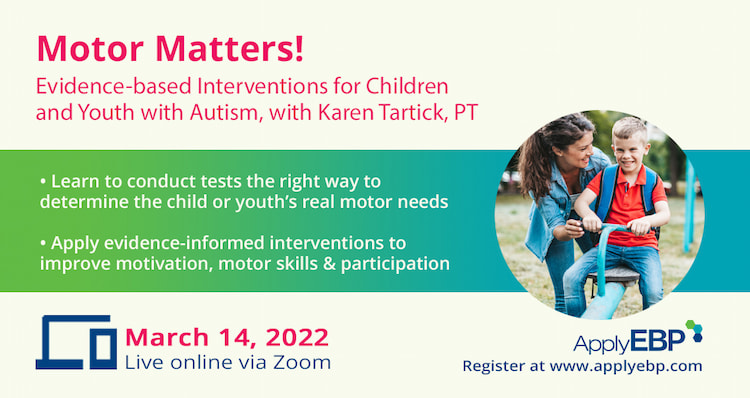
Motor Matters! 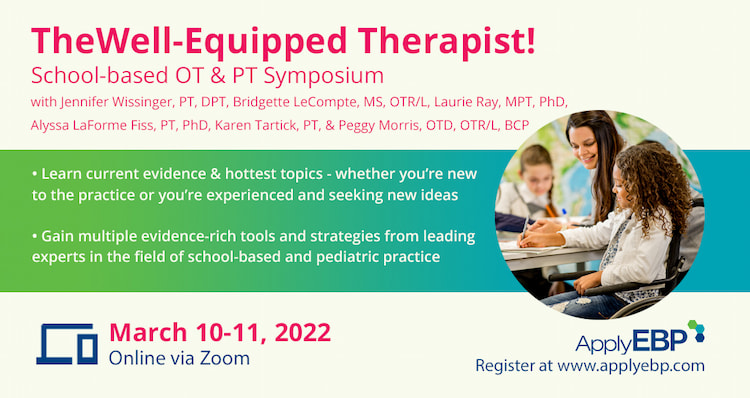
School-based OT & PT Symposiums 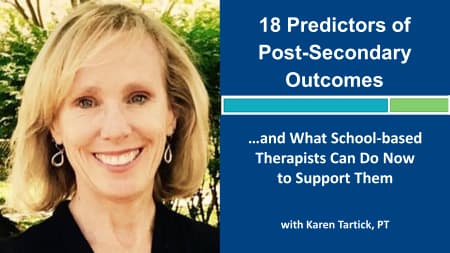
18 Predictors for Post-School Outcomes
A review of the article by Hedgecock, J. B., Dannemiller, L. A., Shui, A. M., Rapport, M. J., & Katz, T. (2018) entitled “Associations of Gross Motor Delay, Behavior, and Quality of Life in Young Children With Autism Spectrum Disorder” Physical therapy, 98(4), 251-259.
Last night my husband and I dropped off our son, Eric, at a weekend mini-camp for children and young adults with Autism Spectrum Disorder (ASD). This will be the third mini-camp for Eric! We are very grateful that this resource is available to him now, as it had not existed until just recently.
This is progress!
As a pediatric therapist who has worked in schools for many years, I have also noticed a similar change in the way we work with students with disabilities. We are shifting our focus from the impairment level and how to “fix” them, to how we can promote inclusion in various activities, both for the individuals and their families. And by doing so, we are aiming to improve their quality of life directly.
I fully embrace this paradigm shift. As pediatric therapists, we can positively facilitate increased participation using real life experiences starting with early intervention, and continuing throughout their school careers and post graduation (Palisano et al, 2017).
That’s why I was very excited to find the article by Hedgecock, J. B., Dannemiller, L. A., Shui, A. M., Rapport, M. J., & Katz, T. (2018) entitled “Associations of Gross Motor Delay, Behavior, and Quality of Life in Young Children With Autism Spectrum Disorder” Physical therapy, 98(4), 251-259.
We now know from recent and ever-increasing research that children with ASD may have motor impairments affecting their
- coordination
- posture
- balance
- motor skills
(Provost et al. ,2007; Bhat et al. 2011; Fournier et al., 2010; Staples & Reid, 2010; Downey & Rapport ,2012).
The recently published article by Hedgecock et al (2018) goes a step further by describing the associations of gross motor delays with problem daytime behavior and Quality of Life (QoL). They reviewed data about the performance of 3,253 children with ASD (ages 2-6 years old) in tests for different variables, such as: communication, gross motor, fine motor, behavior and QoL.
Here is my list of Top 5 Takeaways for Pediatric Therapists (aka Reasons to Address Gross Motor Skills in Children with ASD)
1. ASD is a whole body condition!
- The authors found associations amongst all variables.
- Gross motor scores were significantly associated with fine motor, communication, behavior and quality of life scores.
- Autism severity is also associated with gross motor skills.
- A word of caution: correlation does not necessarily mean causation. However, it is interesting to reflect on the possible interactions among these variables as the authors did, and as we would below.
- Lesson: Look at the whole function of the child!
2. Gross motor delays in children with ASD increases with age.
- The authors found decreasing gross motor scores, as well as increasing number of children with low gross motor scores from age 2 to 6 years.
- The authors did point out that this result may be partly due to widening gap in performance between children with and without ASD become more obvious with increasing motor expectations as they got older.
- However, this may also mean that these delays do not necessarily go away on their own.
- Lesson: Ignoring these motor delays can lead to further delays in motor skills.
3. Gross motor delay was associated with higher levels of internalizing behavior problems.
- Parents of children with ASD struggle with the behavior issues which include externalizing and internalizing problems.
- Externalizing problems are described as increased aggression, poor attention, hyperactivity, and poor impulse control. These externalizing problems are more familiar and associated with ASD – I am sure we have all witnessed an out-of-control behavior in a child with ASD.
- Lesser known are the internalizing problems associated with ASD. These include anxiety, depression, withdrawal, emotional reactivity, over-control, and somatic complaints.
- Children with ASD may exhibit withdrawal and anxiety (i.e., internalizing behaviors) when new motor activities are introduced. This may feed into a vicious cycle of poor internalizing behaviors and delayed motor skills compounding each other.
- The authors noted that “children with internalizing problem behavior may have decreased tolerance to novel movement experiences or self-limit gross motor play activity because of negative experiences (ie, falling) that may reinforce cautious/ anxious behavior.” (Hedgecock et al, 2018)
- We may, for example, look at a young child with ASD who is withdrawn and isolated on the playground. He may have gross motor delays that have not been recognized. We should look at internalizing behaviors as a potential indicator that gross motor skills may be affected.
- Lesson: We should look at both internalizing behaviors and gross motor delays in children with ASD, how they are influencing each other, and work on impacting both if needed.
4. Gross motor delays and internalizing problem behaviors are associated with Quality of Life.
- Behavior problems and adaptive behavior have been associated with the quality of life (QoL) of the majority of children with ASD (Chiang & Wineman, 2014).
- In the article by Hedgecock et al, the authors found that children with internalizing problem behavior had a stronger negative association with QoL than the children with with externalizing problem behavior only.
- Gross motor development was also positively associated with QoL scores.
- Lesson: We need to take into consideration gross motor function and internalizing problem behaviors when designing interventions that promote improved Quality of Life.
5. Our expertise on improving motor skills can play a significant role when working with children with ASD.
- The authors of this study were correct to point out that gross motor performance in children with ASD is often perceived to be a relative strength compared to other “more noticeable deficits.”
- This has often been true in my experience as a school-based therapist. Gross motor skill is an area that has been either ignored or dismissed as teams prioritize the sensory and behavior needs of the child.
- Thus, children with ASD often do not receive interventions to address gross motor delays. We now know these delays often just get worse, and these delays are associated with higher internalizing problem behaviors and lower Quality of Life.
- Good news! Other studies have shown that therapists working with young children with ASD have had success in teaching new motor skills given appropriate supports (Ketcheson et al., 2017; Bremer et al., 2015; Bremer & Lloyd 2016).
- If I may add, there’s another potential benefit to addressing a perceived relative strength…motivation! Aren’t you more motivated to work on something you are good at (versus your weakness)?
- My biggest lesson from this study is that I can contribute in improving gross motor skills of children with ASD, which in turn may help in:
- Cutting the vicious cycle of internalizing behavior problems and gross motor delay
- Positively impacting Quality of Life
My Resolution
As a parent of a son with ASD, the associations found in this study among gross motor skills, fine motor skills, communication, problem behaviors and Quality of Life does not surprise me. I have witnessed them first-hand.
While this study was published in the Physical Therapy Journal, I do not take this study to mean that every child with ASD needs direct services from a physical therapist. What this means is that it is the responsibility of any team that provides care to a child with ASD to ensure that somebody is addressing the child’s gross motor delays. This may mean a physical education teacher during gym class, the classroom teacher via movement breaks, or community providers, such as the mini-camp that Eric now attends.
What encourages me and gives me great hope is the enormous amount of research coming out about ways to improve motor skills, participation and inclusion for children with ASD. So, never will I ever again simply ignore a child with ASD’s gross motor delays and wait for it to worsen with age. I will resolve to investigate them and, if needed, work with the team to design and implement evidence-based strategies to help improve the child’s gross motor skills.
Join the author, Karen and her colleagues in her Apply EBP courses
References:
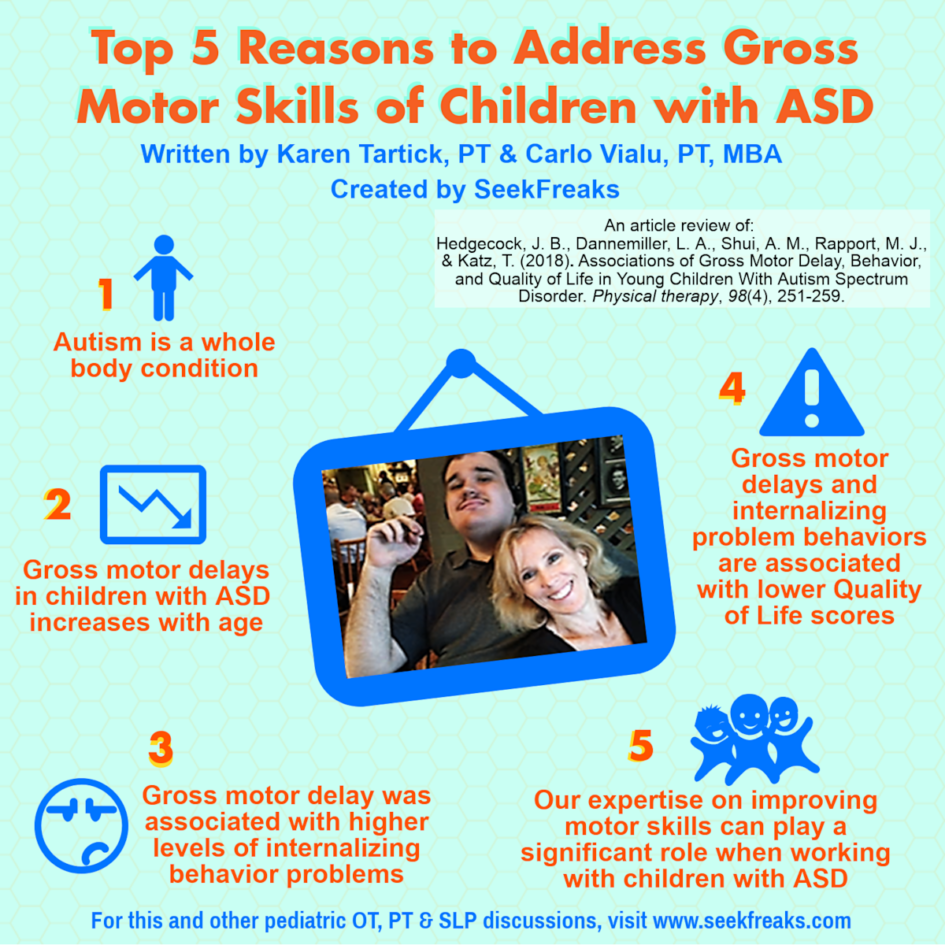

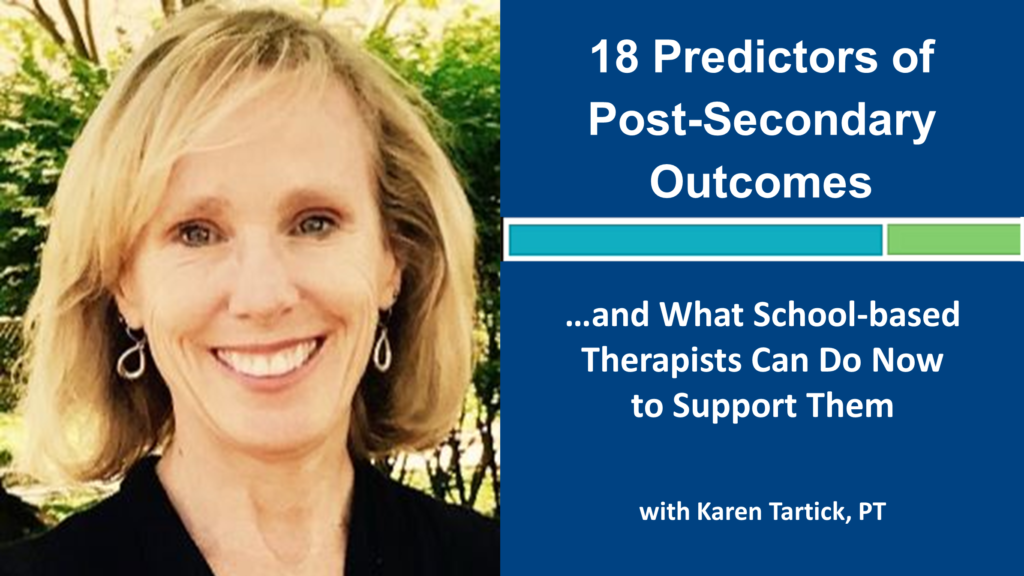












February 14, 2019 at 12:41 pm
Thank you Karen and Carlos for another great article review! I loved it!
February 14, 2019 at 2:08 pm
Thanks, Liliane! This article was a real exciting find 🙂
September 21, 2021 at 8:06 pm
Would love to try motor lab in our school and try an track the benefits/improvement